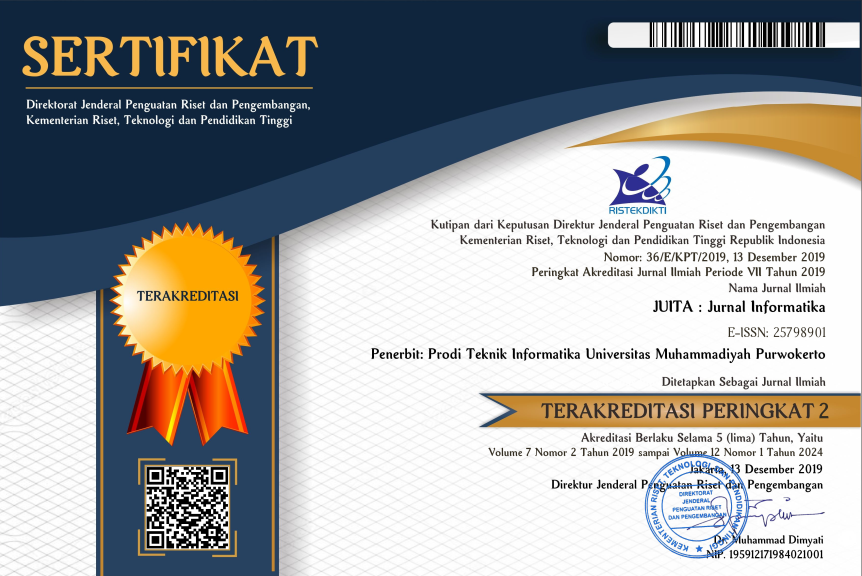Enhancing Durrotalk Chatbot Accuracy Utilizing a Hybrid Model Based on Recurrent Neural Network (RNN) Algorithm and Decision Tree
DOI:
https://doi.org/10.30595/juita.v12i1.20868Keywords:
Chatbot, Artificial Intelligence, Recurrent Neural Network, Decision Tree, Natural Language Processing.Abstract
DurroTalk, a chatbot for new student admissions at Pondok Pesantren Durrotu Ahlissunnah Waljamaah, Semarang, integrates a hybrid model with Recurrent Neural Network (RNN) and Decision Tree. RNN, the base model, employs Natural Language Processing (NLP) to understand sentence structure and context, overcoming vanishing gradient through LSTM layers. The Decision Tree normalizes words, addressing slang and synonyms. The hybrid model boosts chatbot accuracy by 9%, reaching 77% from the initial 68%. This research signifies progress in integrating artificial intelligence into traditional education, showcasing a chatbot adept at handling non-standard language. Decision Tree integration enhances overall performance, making the chatbot proficient in understanding user inputs and generating contextually relevant responses. This study exemplifies the potential of AI, particularly chatbot technology, in modernizing educational processes at traditional institutions.
References
[1] E. N. Sihombing and M. Y. A. Syaputra, “Implementasi Penggunaan Kecerdasan Buatan dalam Pembentukan Peraturan Daerah,” J. Ilm. Kebijak. Huk., vol. 14, no. 3, p. 419, Nov. 2020, doi: 10.30641/kebijakan.2020.V14.419-434.
[2] P. B. Wintoro, H. Hermawan, M. A. Muda, and Y. Mulyani, “Implementasi Long Short-Term Memory pada Chatbot Informasi Akademik Teknik Informatika Unila,” Expert J. Manaj. Sist. Inf. dan Teknol., vol. 12, no. 1, p. 68, Jun. 2022, doi: 10.36448/expert.v12i1.2593.
[3] M. Fahmi, “Mengenal Tipologi Dan Kehidupan Pesantren,” J. Pendidik. dan Pranata Islam SYAIKHUNA, vol. 6, p. 301, 2015.
[4] A. W. Al Qorni, “Manajemen Rekrutmen Santri Tahfidz Al Qu’ran Tingkat Madrasah Aliyah,” Rayah Al-Islam, vol. 5, no. 02, pp. 506–513, Oct. 2021, doi: 10.37274/rais.v5i02.480.
[5] J. Y. Zhang et al., “China’s First Natural Language-based AI ChatBot Trader,” in Companion Proceedings of the ACM Web Conference 2023, New York, NY, USA: ACM, Apr. 2023, pp. 1253–1256. doi: 10.1145/3543873.3587633.
[6] A. Biju, N. S. Menon, S. L. Joseph, D. Lopez, and S. Pj, “Medical Chatbot (Medibot),” Int. J. Adv. Trends Comput. Sci. Eng., vol. 10, no. 3, pp. 2171–2174, 2021, doi: 10.30534/ijatcse/2021/941032021.
[7] Y. W. Chandra and S. Suyanto, “Indonesian Chatbot Of University Admission Using A Question Answering System Based On Sequence-To-Sequence Model,” Procedia Comput. Sci., vol. 157, pp. 367–374, 2019, doi: 10.1016/j.procs.2019.08.179.
[8] R. Tiwari, G. M. S. S. Pranav, and M. R. Prema, “A Research Paper on Human Machine Conversation Using Chatbot,” Int. Res. J. Eng. Technol., 2021, [Online]. Available: www.irjet.net
[9] P. Anki, A. Bustamam, H. S. Al-Ash, and D. Sarwinda, “Intelligent Chatbot Adapted from Question and Answer System Using RNN-LSTM Model,” J. Phys. Conf. Ser., vol. 1844, no. 1, 2021, doi: 10.1088/1742-6596/1844/1/012001.
[10] T. A. Zuraiyah, D. K. Utami, and D. Herlambang, “Implementasi Chatbot Pada Pendaftaran Mahasiswa Baru Menggunakan Recurrent Neural Network,” J. Ilm. Teknol. dan Rekayasa, vol. 24, no. 2, pp. 91–101, 2019, doi: 10.35760/tr.2019.v24i2.2388.
[11] R. Arifudin, D. I. Wijaya, B. Warsito, and A. Wibowo, “Voting Classifier Technique and Count Vectorizer with N-gram to Identifying Hate Speech and Abusive Tweets in Indonesian,” Sci. J. Informatics, vol. 10, no. 4, pp. 469–478, 2023, doi: 10.15294/sji.v10i4.46633.
[12] S. Sun, C. Luo, and J. Chen, “A Review of Natural Language Processing Techniques for Opinion Mining Systems,” Inf. Fusion, vol. 36, pp. 10–25, Jul. 2017, doi: 10.1016/j.inffus.2016.10.004.
[13] S. Memon et al., “Comparative Study of Truncating and Statistical Stemming Algorithms,” 2020. [Online]. Available: www.ijacsa.thesai.org
[14] A. G. Qasem and S. S. Lam, “Prediction of Wart Treatment Response Using a Hybrid GA-Ensemble Learning Approach,” Expert Syst. Appl., vol. 221, Jul. 2023, doi: 10.1016/j.eswa.2023.119737.
[15] R. Patil, S. Boit, V. Gudivada, and J. Nandigam, “A Survey of Text Representation and Embedding Techniques in NLP,” IEEE Access, vol. 11, pp. 36120–36146, 2023, doi: 10.1109/ACCESS.2023.3266377.
[16] A. Lopez, M. Martin, A. P. Lluna, and R. Saidi, “Effect of Sequence Padding on The Performance of Deep Learning Models in Archaeal Protein Functional Prediction,” Sci. Rep., no. 0123456789, pp. 1–14, 2020, doi: 10.1038/s41598-020-71450-8.
[17] D. Tarkus, S. R. U. A. Sompie, and A. Jacobus, “Implementasi Metode Recurrent Neural Network pada Pengklasifikasian Kualitas Telur Puyuh,” J. Tek. Inform., vol. 15, no. 2, pp. 137–144, 2020.
[18] P. G. Benardos and G. Ã. Vosniakos, “Optimizing Feedforward Artificial Neural Network Architecture,” vol. 20, pp. 365–382, 2007, doi: 10.1016/j.engappai.2006.06.005.
[19] M. Ozcan and S. Peker, “A Classification and Regression Tree Algorithm for Heart Disease Modeling and Prediction,” Healthc. Anal., vol. 3, Nov. 2023, doi: 10.1016/j.health.2022.100130.
[20] O. Mehrpour et al., “Comparison of Decision Tree With Common Machine Learning Models for Prediction of Biguanide and Sulfonylurea Poisoning in The United States: an Analysis of The National Poison Data System,” BMC Med. Inform. Decis. Mak., vol. 23, no. 1, p. 60, Dec. 2023, doi: 10.1186/s12911-022-02095-y.
[21] N. A. Purwitasari and M. Soleh, “Implementasi Algoritma Artificial Neural Network Dalam Pembuatan Chatbot Menggunakan Pendekatan Natural Language Parocessing,” J. IPTEK, vol. 6, no. 1, Mar. 2022, doi: 10.31543/jii.v6i1.192.
[22] N. Hikmah, D. Ariyanti, and F. A. Pratama, “Implementasi Chatbot Sebagai Virtual Assistant di Universitas Panca Marga Probolinggo menggunakan Metode TF-IDF,” JTIM J. Teknol. Inf. dan Multimed., vol. 4, no. 2, pp. 133–148, 2022, doi: 10.35746/jtim.v4i2.225.
Downloads
Additional Files
Published
How to Cite
Issue
Section
License

JUITA: Jurnal Informatika is licensed under a Creative Commons Attribution 4.0 International License.
















